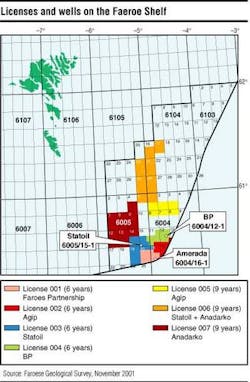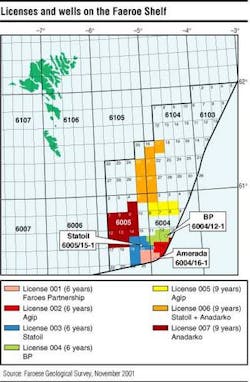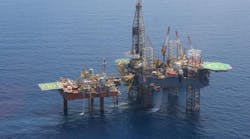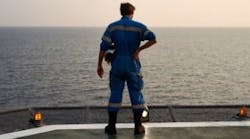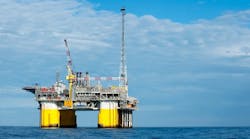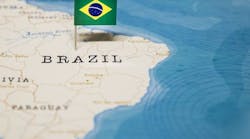In the fall of 2001 the Faeroes Partnership, with Amerada Hess as operator, made the first substantial hydrocarbon discovery on the Faeroe Shelf, named Marjun. The find was made 18 months after the first licensing round on the Faeroe Shelf officially opened.
First licensing round
The geology in the area offered for licensing varied, with large parts covered by thick layers of basalt. Two types of license terms were included in the first licensing round. Six years are allowed for licenses in the area to the southeast, which is characterized by little or no basalt layers and for which substantial quantities of seismic data were available. Nine years are offered for the area to the northwest, which was considered more challenging. The 9-year licenses are in two parts. The first part is a work program for the initial three years, following which the license holder and the petroleum authorities must decide whether to extend the term by another 6 years with a corresponding well commitment.
On Aug. 17, 2000, seven exploration and production licenses were awarded to 12 companies, two of which were Faeroese companies. Four of the licenses are 6-year licenses while three are granted for 9 years. The total acreage awarded constitutes roughly 30% of the area originally on offer.
Competition for the areas on offer was intense, and there was considerable overlap between the applications. There were two main award criteria for the individual licenses, namely the geological understanding and the work program, which the oil companies would undertake to thoroughly explore for hydrocarbons in the licensed area, and the degree to which the license holders would secure genuine opportunities for Faeroese companies to participate in petroleum activities. The Ministry of Petroleum is satisfied with the outcome of the licensing round, which covers eight well commitments and further 3D seismic surveys for the 6-year licenses, various geological and geophysical surveys for the 9-year licenses, approximate investment of DKr40 million for the Sindri project and approximately DKr85 million for Faeroese participation.
Licensing terms – Faeroese participation
The licenses contain stipulations requiring the license holders to service their offshore installations through a Faeroese harbour and conduct all crew changes through a Faeroese airport. In addition, Faeroese companies will, in competition with others, have access to obtain contracts and subcontracts and to provide goods and services to the oil industry.
The purpose of the local participation policy is to strengthen the qualifications of Faeroese companies and individuals, in the hope that it will lead to a raising of competence in the local industry and, in the long term, improve the competitiveness of Faeroese undertakings, not only locally but also internationally. For other features of the first licensing round such as the fiscal and safety regimes, please see the web page of the Ministry of Petroleum, www.oms.fo.
Exploration results
Since the discovery of the Foinaven and Schiehallion fields on the Atlantic Margin in the early ’90s, the entire area has seen a substantial number of exploration wells, but these have not yet yielded the expected results. Still, great expectations were raised by the exploration wells drilled on the Faeroe Shelf last summer, not only by the involved oil companies and the Faeroese authorities and community, but also by the oil industry as a whole.
Three wells were drilled during this first year of exploration. The Statoil group with license 003 spudded its well 6005/15-1 in July 2001, followed by the BP/Shell well 6004/12-1 in license 004. The Faeroes Partnership, holding license 001, closed the season by drilling the well 6004/16-1.
Statoil’s well was drilled to a total depth of 4,000 m below sea level, terminating in layers of Paleocene age. It encountered traces of hydrocarbons. The BP well demonstrated the presence of both oil and gas on the Faeroe Shelf, although in non-commercial quantities. The well was drilled to 4,354 m below sea level to layers of Paleocene age.
Amerada Hess’ well, which was drilled to a total depth of 4,246 m below sea level, contained significant quantities of hydrocarbons over a gross column of 170 m. The find was made when the well was extended deeper into the geological section than originally planned, thereby establishing the presence of hydrocarbons at deeper layers than expected. The well was terminated in layers of lower Paleocene age.
In retrospect, none of the main targets of last year’s wells turned out as predicted. However, the establishment of an active hydrocarbon system on the Faeroe Shelf is considered important for future exploration activities in the area and substantiates the expectations that hydrocarbon accumulations may be present elsewhere on the Faeroe Shelf.
Future licensing rounds
The Ministry of Petroleum believes it is premature to speculate on the launching of a second licensing round. This will be considered once the petroleum authorities evaluate the information acquired from last year’s exploration activities. The results of the geological and geophysical surveys, carried out under the initial three years of the 9-year licenses, also are not yet available.
The Sindri group comprising the license holders in conjunction with the Faeroese Geological Survey is another important factor in this context. Its main focus is to implement joint projects of relevance for future investigation of the Continental Shelf. For further information on the Sindri group and its projects, please see www.sindri.fo.
Challenges ahead
The three wells last summer have provided the petroleum authorities and the oil companies with substantial volumes of information. It will take time for the parties involved to fully understand the geology and the hydrocarbon potential of the area. Such understanding is key to the planning of future exploration activities on the shelf.
The unexpected results of the wells sent the involved parties back to the drawing board. The seismic data and the geological models on which the wells were planned need to be carefully studied and compared with the data acquired from the wells. New geological models for the Faeroe Shelf have to be prepared. This may delay the drilling of the remaining five wells, but from the perspective of the petroleum authorities, the main focus is to allow careful planning to progress the drilling of future wells, thus enhancing the possibilities of finding hydrocarbons in commercial quantities.
Currently the government is awaiting the report, which the Faeroes Partnership will submit pending the final result of their find. This will include a detailed program assessing the work required to establish whether the prospect contains commercial quantities of hydrocarbons. With this find petroleum exploration in the Faeroes area stands at a crossroads. If commercial, it will play a major role when identifying future prospects in the area and give rise to further expectations regarding commercial quantities of hydrocarbons in deep layers elsewhere on the Faeroe Shelf and on the Atlantic Margin as a whole.
